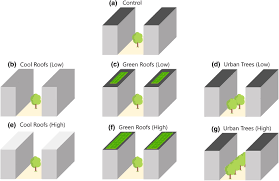New Tool Identifies Urban Heat Mitigation Strategies in Vulnerable Houston Neighborhoods

As cities face increasingly intense heatwaves, researchers at The University of Texas at Austin have developed a groundbreaking tool to identify effective strategies for keeping neighborhoods cooler. This new physics-based computer modeling framework integrates indices of human comfort and social vulnerability with heat island mitigation strategies and advanced urban climate modeling. The findings were published in *PNAS Nexus*.
In their application of this index to Houston, the researchers discovered that trees, rather than roof treatments, offered the best relief from heat in the most vulnerable areas of the city. Vulnerability was assessed based on factors such as socioeconomic status, household composition, and minority status, alongside adaptive capacity indicators like housing type and access to transportation.
Heat islands occur in urban areas where buildings and roads absorb more sunlight than natural landscapes, leading to elevated temperatures, increased energy consumption, and compromised human health and comfort. This effect varies significantly across different neighborhoods, intensifying the challenge for city planners.
The research introduces the universal thermal comfort index, which takes into account temperature, humidity, wind speed, and solar radiation to quantify how urban heat affects human comfort. Prior studies had largely overlooked the impact of direct sunlight on comfort levels in urban environments. "For construction workers working under direct sunlight versus those shaded by trees, comfort levels will differ dramatically," explained Zong-Liang Yang, one of the lead researchers.
The study examined three heat island mitigation strategies: painting roofs white to enhance solar reflectance, implementing vegetation on roofs for increased evaporation, and planting trees for shade and cooling. While painting roofs white resulted in the most significant decrease in heat index during the day in a generic city block, the outcomes varied when considering different neighborhoods in Houston.
Utilizing the social vulnerability index developed by the U.S. Centers for Disease Control and Prevention, the researchers classified Houston neighborhoods by their vulnerability levels. Their analysis revealed that in areas with lower vulnerabilities, painting roofs white was the optimal cooling strategy, while in more vulnerable neighborhoods, planting trees proved to be more effective. "By combining the cooling index with vulnerability data, we can pinpoint which methods will offer more relief to at-risk neighborhoods," said lead author Kwun Yip Fung, who conducted this research as part of his doctoral studies.
Interestingly, neighborhoods with higher vulnerability also had more available space for tree planting, while they had less roof area suitable for painting or vegetation. "Now that we know vulnerable neighborhoods have more room for trees, we should prioritize tree planting in those areas," Fung stated. Conversely, in less vulnerable areas, strategies like cool roofs and green roofs should take precedence.
Adapting this methodology to other cities will require additional considerations, such as selecting heat and drought-tolerant trees in arid regions like Arizona, or addressing the absence of air conditioning in northern communities vulnerable to heat. The researchers envision that their methodology could also support hybrid strategies, integrating both rooftop treatments and tree planting, alongside reflective pavements. "This is just the beginning; our index and methodology can be applied to numerous scenarios moving forward," Fung concluded.
Story Source:
Materials provided by University of Texas at Austin. The original text of this story is licensed under a Creative Commons License. Note: Content may be edited for style and length.
Journal Reference:
- Kwun Yip Fung, Zong-Liang Yang, Alberto Martilli, E Scott Krayenhoff, Dev Niyogi. Prioritizing social vulnerability in urban heat mitigation. PNAS Nexus, 2024; 3 (9) DOI: 10.1093/pnasnexus/pgae360

0 Comments